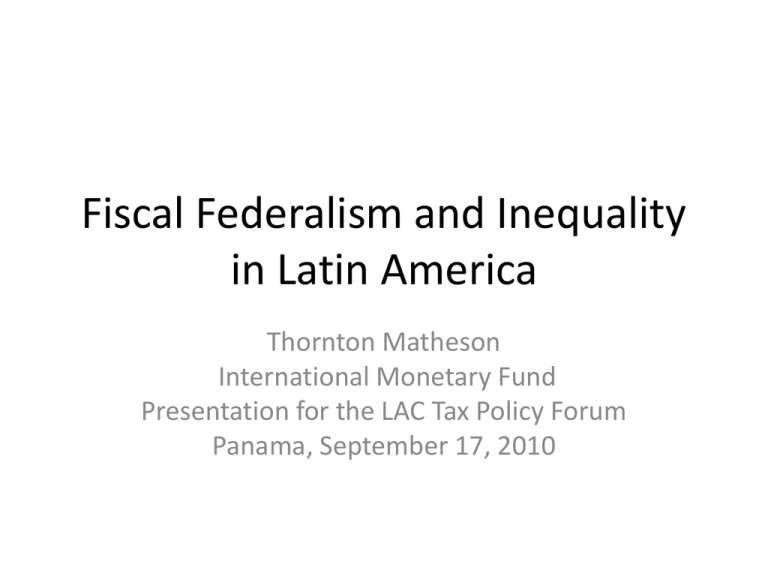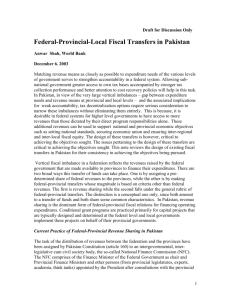Thornton Matheson
advertisement

Fiscal Federalism and Inequality in Latin America Thornton Matheson International Monetary Fund Presentation for the LAC Tax Policy Forum Panama, September 17, 2010 Overview • • • • • Theory of fiscal federalism Practice of fiscal federalism in Latin America General reform goals Local Government (LG) revenue instruments Design of interjurisdictional redistribution Fiscal Federalism: Theory • Where regional preferences differ, devolution of fiscal authority can improve allocative efficiency and welfare. • To achieve this, LGs must be accountable to local constituents – Raise own revenues at the margin – Significant discretion over spending Fiscal Devolution: Constraints • Interregional factor mobility • Local administrative resources • Macroeconomic stabilization – LG soft budget constraints – Excessive devolution • Regional tax base disparities* – Economic activity often concentrated in a few large cities – Natural resource wealth also unevenly distributed Fiscal Federalism and Interpersonal Inequality • LGs often largely responsible for social welfare spending (health, education) critical to reducing inequality • LGs with poorer constituencies often have smaller PC tax bases – Necessitates interjurisdictional transfers Fiscal Federalism in Latin America • Expenditure: Relatively low level of devolution • Revenues: Low level of own revenues Table 1: Region LG Share of Expenditure LG Share of Revenues OECD 30.6 22.7 Latin America 19.4 11.7 Source: http://www1.worldbank.org/publicsector/decentralization/fiscalindicators.htm Data include shared revenues, but exclude transfers Fiscal Federalism in Latin America • Mismatch between revenues and expenditures • Heavy reliance on transfers and revenue sharing – Most major tax bases assigned to center – Transfers/revenue sharing often pro-cyclical • Extensive earmarking of transfers – Many LGs have little discretion over spending – Vertically overlapping spending responsibilities FF in LAC: Tax Assignment • Most major bases assigned to center: – – – – – – CIT: national PIT: national (except Brazil and Mexico) Asset: national VAT: national (except Brazil) Sales: national Excises: national/state • States and local tax bases more limited: – Vehicles: state – Property: state/municipal – Business taxes: municipal • Natural Resources: shared Source: Amhad & Brosio (2008), 7 largest LAC countries FF in Latin America: Consequences • Revenue dependency and earmarking undermine LG accountability – Poor incentives to develop own revenue sources – Poor incentives for efficient service provision • Procyclical revenues and revenue/expenditure mismatch encourage LG deficit financing – Soft budget constraints can threaten macroeconomic stability FF in Latin America: Reform Goals • Develop LG own revenue sources – Low cyclicality – Progressive – Evenly distributed across jurisdictions • Constrain LG deficit spending • Make transfer system transparent, fair and reliable – Reduce earmarking Revenues: Property Tax • Advantages: – Immobile base – Progressive – Low cyclicality • Disadvantages: – Administration complex – Interregional base disparities Revenues: Property Tax • Chief source of own revenue for LGs in LAC • However, productivity relatively low: – OECD average: 2.6% GDP – Developing countries: 0.6% GDP • • • • Mexico: 0.2% Brazil: 0.5% Argentina: 0.4% Colombia: 1% – Problem: Low tax rates, poor cadastres, administrative capacity, lack of political will to enforce Revenues: Consumption Taxes • VAT, sales taxes, destination-based excises – E.g., Brazil (ICMS), Colombia (alcohol, cigarettes, gasoline), Argentina (turnover) • Advantages: – Low cyclicality relative to income taxes – Geographically dispersed – Destination basis generally avoids tax competition (except cross-border shopping) • Disadvantages: – Subnational VAT complex, distortive – Sales taxes cascade, avoidable, narrow bases – Origin-based excises more efficient Revenues: Income-type VAT • Advantages: – Broader base than CIT, buoyant revenue source – Benefit charge for local businesses – Alternative to commercial property tax • Disadvantages: – Geographic concentration – Tax competition (origin-based) – Cyclicality (but less so than CIT) • Examples: – IRAP (Italy, regional) raises 2.5% of GDP – IETU (Mexico, federal) has some similarities Revenues: PIT Surcharge • CG sets base, LGs allowed to set own rate (perhaps within limits) • Advantages: – Administrable (CG can collect) – Progressive • Disadvantages: – Cyclicality – Base mobility • Some CGs share PIT revenue with LGs (e.g., Brazil, Mexico). – Unlike surcharge, this is not LG own revenue. – US: Many states impose own PITs on federal PIT base. Revenues: Natural Resource Taxes • Theory dictates these should be CG taxes: – Uneven regional tax base – Potentially complex – Volatile revenues • However, they are often shared with LGs. – Need for infrastructure, environmental cleanup – Local population ownership claims • Examples: – Bolivia: Departments receive about 2/3 of gas rents and 1/3 hydrocarbon income tax (IDH). Municipalities receive ¼ of IDH. – Colombia: 48% oil royalties go to departments, 13% to municipalities, 8% ports. • Possible alternative: Production excises with redistribution – May also create stabilization fund to counter revenue volatility Interjurisdictional Redistribution • Given disparities in LG tax bases and administrative constraints, LAC countries will likely remain fairly reliant on revenue sharing and transfers. • Greater decentralization itself leads to more transfers – OECD: elasticity of total transfers with respect to LG own revenue share = 1.5 • Redistribution therefore needs to be well designed to promote LG accountability and hard budget constraints. Transfer Design • Transfers should not be based on historical LG revenue or spending patterns – This creates incentive for LGs to undertax and/or overspend. • Transfers should be based on the difference between ex ante LG revenue capacity and spending requirements – Revenue capacity: Apply average tax rate to average base, or macroeconomic measure of GRP, income PC • Transfers could be varied anti-cyclically – In practice, transfers are often pro-cyclical – “Rainy day funds”











